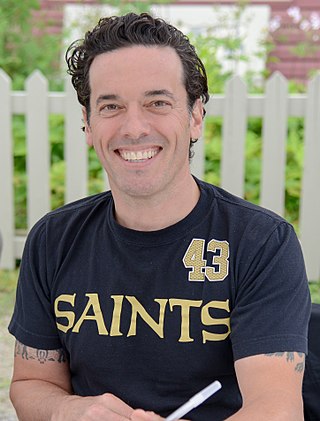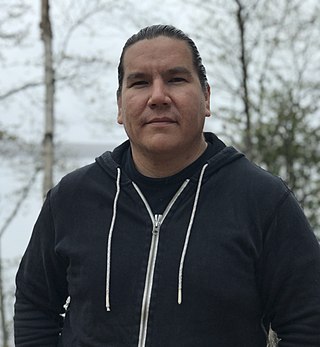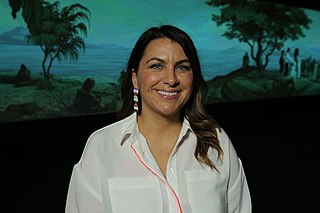Related Research Articles
Drew Hayden Taylor is an Indigenous Canadian playwright, author and journalist.

Joseph Boyden is a Canadian novelist and short story writer of Irish and Scottish descent. He also claims Indigenous descent, but this is widely disputed. Joseph Boyden is best known for writing about First Nations culture. Three Day Road, a novel about two Cree soldiers serving in the Canadian military during World War I, was inspired by Ojibwa Francis Pegahmagabow, the legendary First World War sniper. Joseph Boyden's second novel, Through Black Spruce, follows the story of Will, son of one of the characters in Three Day Road. The third novel in the Bird family trilogy was published in 2013 as The Orenda.

Kegedonce Press is an Indigenous publishing house in Neyaashiinigmiing Reserve No. 27, Ontario, Canada, owned by Kateri Akiwenzie-Damm. Started in 1993, it is one of only a handful of dedicated Indigenous publishers in Canada. Their motto is "w'daub awae", which means "speaking true" in Ojibwe. Kegedonce Press describes itself as committed to the publication of beautifully written and designed Indigenous literature, both nationally and internationally. They are the only Indigenous publisher that prioritizes poetry, as Kateri is a poet and recognizes that many new Indigenous authors begin their writing careers as poets.
Basil H. Johnston was an Anishinaabe (Ojibwa) and Canadian writer, storyteller, language teacher and scholar.
Anita E. Kunz, OC, DFA, RCA is a Canadian-born artist and illustrator. She was the first woman and first Canadian to have a solo exhibit at the Library of Congress in Washington, D.C.

Wasauksing First Nation is an Ojibway, Odawa and Pottawatomi First Nation band government whose reserve is located near Parry Sound in Ontario, Canada.

Christi Marlene Belcourt is a Métis visual artist and author living and working in Canada. She is best known for her acrylic paintings which depict floral patterns inspired by Métis and First Nations historical beadwork art. Belcourt's work often focuses on questions around identity, culture, place and divisions within communities.

Michelle LaVallee is a Canadian curator, artist, and educator. She is Ojibway and a member of the Chippewas of Nawash Unceded First Nation in Cape Croker, Ontario. She has BFA (2000) and BEd (2004) degrees from York University in Toronto.
Skawennati is a Mohawk multimedia artist, best known for her online works as well as Machinima that explore contemporary Indigenous cultures, and what Indigenous life might look like in futures inspired by science fiction. She served as the 2019 Indigenous Knowledge Holder at McGill University. In 2011, she was awarded an Eiteljorg Contemporary Art Fellowship which recognized her as one of "the best and most relevant native artists."

Cheryl L'Hirondelle is a Canadian multidisciplinary media artist, performer, and award-winning musician. She is of Métis/Cree (non-status/treaty), French, German, and Polish descent. Her work is tied to her cultural heritage. She explores a Cree worldview or nêhiyawin through body, mind, emotions, and spirit; examining what it means to live in contemporary space and time.
Indigenous peoples of Canada are culturally diverse. Each group has its own literature, language and culture. The term "Indigenous literature" therefore can be misleading. As writer Jeannette Armstrong states in one interview, "I would stay away from the idea of "Native" literature, there is no such thing. There is Mohawk literature, there is Okanagan literature, but there is no generic Native in Canada".

Cherie Dimaline is a Métis writer from the Georgian Bay Métis Nation, a federally recognized community in Ontario. She has written a variety of award-winning novels and other acclaimed stories and articles. She is most noted for her 2017 young adult novel The Marrow Thieves, which explores the continued colonial exploitation of Indigenous people.
Barry Ace (artist) (born 1958) is an Anishinaabe (Odawa) photographic and multimedia artist and curator from Sudbury, Ontario. Ace's work includes mixed media paintings, and mixed media textile and sculptural work that combines traditional Anishinaabe textiles and beadwork with found electrical components. Ace has a strong interest in combining traditional and contemporary technologies, aesthetics, and techniques in his artwork.
Âhasiw Maskêgon-Iskwêw (1958–2006) was a Cree and French Métis theorist, curator and artist. Maskêgon-Iskwêw was a significant figure in the field of contemporary Indigenous arts, and a formative proponent of digital media within Indigenous communities. In their 2015 book dedication to him, Steven Loft and Kerry Swanson describe Maskêgon-Iskwêw as "one of the foremost thinkers and practitioners of Aboriginal new media art."
Tsēma Igharas, formerly known as Tamara Skubovius, is an interdisciplinary artist and member of the Tāłtān First Nation based in Vancouver, British Columbia. Igharas uses Potlatch methodology in making art, to assert the relationships between bodies and the world, and to challenge colonial systems of value and measurement of land and resources.

Waubgeshig Isaac Rice is an Anishinaabe writer and journalist from the Wasauksing First Nation near Parry Sound, Ontario, in Canada. Rice has been recognized for his work throughout Canada, including an appearance at Wordfest's 2018 Indigenous Voices Showcase in Calgary.
Alan Rodney Bobiwash (1959–2002) was an Anishinaabe First-Nations activist and scholar for Indigenous histories, racial equality, and social justice. He taught at the University of Manitoba, Trent University, and the University of Toronto. At the University of Toronto, he also directed First Nations House and Aboriginal Student Services (1994–97), paving the way for expanded First Nations student support in education.
Chief Lady Bird is a Chippewa and Potawatomi artist, illustrator, educator and community activist from Rama First Nation and Moosedeer Point First Nation, who currently resides in Toronto, Ontario. Chief Lady Bird (Ogimaakwebnes) is her spirit name, which she uses professionally as an artist. Her art is focused on foregrounding the experiences of Indigenous women.

Dr. Julie Nagam is a scholar, artist, and curator based in Winnipeg, Canada.
The Festival of Literary Diversity is an annual literary festival, which takes place in Brampton, Ontario, Canada. Founded in 2016 by Jael Richardson, the festival serves to promote and publicize literature by writers from underrepresented groups, such as Black Canadians, indigenous Canadians, Asian Canadians, disabled and LGBTQ writers, who are frequently overlooked by mainstream literary festivals.
References
- ↑ "Teachings from the Muskrat". Muskrat Magazine. 4 March 2013. Retrieved 12 May 2016.
- ↑ "Panel Speaker: Rebeka Tabobondung | OCAD University Research". OCAD University. Retrieved 12 May 2016.
- ↑ "Toronto Aboriginal Business Association 2012 Awards". Turtle Island. Retrieved 12 May 2016.
- ↑ Kurek, Dominik (8 June 2015). "Q & A with North York library's writer-in-residence Cherie Dimaline". North York Mirror. Metroland Media Group. Retrieved 14 May 2016.
- ↑ "Toronto artist's work bridges traditional and urban First Nations life". CityNews. Toronto: Rogers Media. 6 November 2011. Retrieved 14 May 2016.